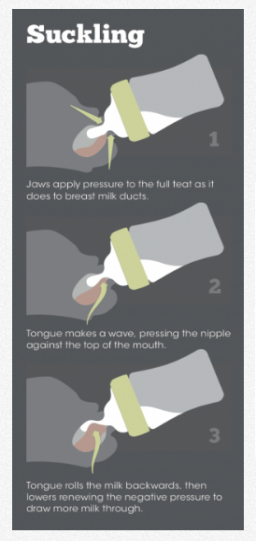A solution to help prolong breastfeeding
A solution to complement breastfeeding which works by responding to a baby's natural suckling action, giving nursing mothers more flexibility, so they are encouraged to breastfeed for longer.
 Breastfeeding is something that most mothers want to do in the interest of the health and well-being of their child and encouragement could make a big difference. Moderate increases in breastfeeding would translate into millions of pounds of cost savings for the NHS and tens of thousands of fewer hospital admissions and GP consultations. If 45 per cent of women were to exclusively breastfeed for four months, and if 75 per cent of babies in neonatal units were breastfed at discharge, a massive £17 million could be gained annually every year by avoiding the costs of treating diseases in infants.1
Breastfeeding is something that most mothers want to do in the interest of the health and well-being of their child and encouragement could make a big difference. Moderate increases in breastfeeding would translate into millions of pounds of cost savings for the NHS and tens of thousands of fewer hospital admissions and GP consultations. If 45 per cent of women were to exclusively breastfeed for four months, and if 75 per cent of babies in neonatal units were breastfed at discharge, a massive £17 million could be gained annually every year by avoiding the costs of treating diseases in infants.1
There has been a drive in recent years to improve breastfeeding support and increase breastfeeding in the UK. The last Infant Feeding Survey (published in 2012)2 indicated that there was increase in the prevalence of exclusive breastfeeding at birth (from 65 per cent in 2005 to 69 per cent in 2010), however, there was little change thereafter up until six weeks.

Importantly, the fall-out rate in later months was lower in 2010 than 2005. At one week, less than half of all mothers (46 per cent) were exclusively breastfeeding, while this had fallen to around a quarter (23 per cent) by six weeks. By six months, levels of exclusive breastfeeding had decreased to one per cent, indicating that very few mothers were following the UK health departments’ recommendation that babies should be exclusively breastfed until around the age of six months.
A controversial pilot study in Sheffield to give new mothers £200 vouchers to breastfeed their babies breast milk for up to six months, sparked widespread disapproval. Critics rounded on the scheme saying money was not the way to increase take-up of breastfeeding, and the scheme would penalise women who were unable to breastfeed.
The early discontinuation of breastfeeding is not a decision that is taken lightly by most women. Many mothers are distressed when they discontinue breastfeeding and this distress can be exacerbated by guilt, inadequacy and failure, or the condemnation of others. Sadly, once conventional bottle-feeding is started, babies frequently reject the breast in favour of a bottle, if they have to work less actively. Giving conventional bottles to young, breastfeeding babies often leads to nipple confusion because the basic mechanical differences between how a baby draws milk from a conventional bottle and how a baby breastfeeds, are different.
 Women in the UK often use mixed feeding methods, either out of choice or as a result of constraints, such as experiencing feeding problems or having to be away from their baby but, until now, no feeding solution has existed that nursing mothers could turn to that mirrored the mechanics of breastfeeding, providing reassurance, more flexibility and more encouragement to breastfeed for longer.
Women in the UK often use mixed feeding methods, either out of choice or as a result of constraints, such as experiencing feeding problems or having to be away from their baby but, until now, no feeding solution has existed that nursing mothers could turn to that mirrored the mechanics of breastfeeding, providing reassurance, more flexibility and more encouragement to breastfeed for longer.
Over the last 150 years, the baby bottle and teat has seen a multitude of ameliorations and many aesthetic improvements. However, popular vented baby bottles have been teaching babies a different way to feed. In spite of numerous claims and counter-claims, until the development of the Suckle Feeder, no technological advances had been made that enabled babies to actively suckle when bottle-feeding.
Suckle feeding properly exercises a baby's oral muscles, encouraging oral development, actively engaging over 40 individual muscles. It also encourages controlled, slower feeding and longer suckling, ensuring a baby avoids guzzling and overfeeding and follows the same growth pattern as a breastfed baby.
Babies are all born with an in-built, near-perfect, appetite control mechanism. Just as there are critical periods in brain development that allow babies to reach milestones such as the ability to track movement with their eyes or acquire language, so there is now evidence that babies also have a ‘developmental window’ in which to set their appetite. If, during this period, the baby’s natural ability to self-regulate food intake is overridden, an infant is likely to put on weight rapidly, setting into motion biological and behavioural changes that will predispose him to a lifelong fight against flab.
Published medical research shows a link between rapid weight gain in the early months of life and obesity, heart disease and diabetes in later life. Child obesity is one of the health risks associated with not breastfeeding.3
REFERENCES
3 Early Feeding Patterns Shape Future Appetite
Boots.com breastfeeding mothers' have their say:








